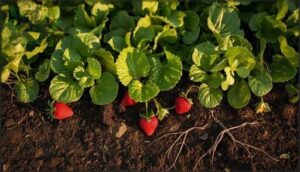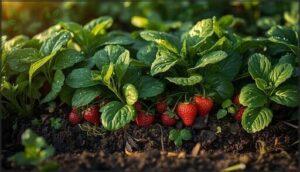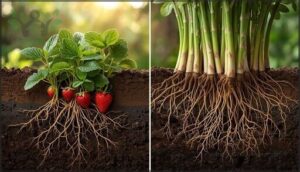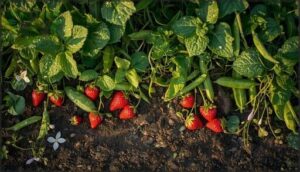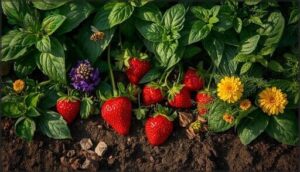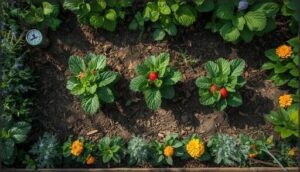This site is supported by our readers. We may earn a commission, at no cost to you, if you purchase through links.
Planting strawberries alongside the right companions can boost your harvest by up to 35% while slashing pest problems naturally. The secret lies in strategic polyculture—pairing your berries with plants that repel aphids and slugs, attract pollinating insects, or enrich the soil with nitrogen.
Yet many gardeners unknowingly sabotage their strawberry beds by choosing companions that harbor diseases, compete aggressively for nutrients, or release growth-inhibiting compounds into the soil.
Understanding which plants work as allies and which act as adversaries transforms your strawberry patch from a vulnerable monoculture into a resilient, productive ecosystem that practically tends itself.
Table Of Contents
- Key Takeaways
- Benefits of Companion Planting for Strawberries
- Best Vegetable Companions for Strawberries
- Top Herbs and Flowers for Strawberries
- Plants to Avoid Near Strawberries
- Companion Planting Tips for Strawberry Gardens
- Frequently Asked Questions (FAQs)
- What can’t be planted next to strawberries?
- What is the best thing to put around strawberry plants?
- What is complementary to strawberry?
- What is the best pollinator for strawberries?
- When should companion plants be planted alongside strawberries?
- How far apart should companion plants be spaced?
- Which companion plants work best in containers?
- Can companion plants reduce strawberry runner production?
- What companion plants thrive in partial shade conditions?
- How often should strawberry companion plants be watered?
- Conclusion
Key Takeaways
- Strategic companion planting can boost strawberry harvests by up to 35% while cutting pest problems by 16–64% depending on your plant pairings and pest types.
- Best companions like borage, garlic, and lettuce work through distinct mechanisms—attracting pollinators, repelling pests, and improving soil health without competing for resources.
- Avoid nightshades, brassicas, and sprawling vines like cucumbers, which harbor diseases, deplete soil nitrogen aggressively, and reduce yields by 15–40% through competition and shading.
- Proper spacing (6–18 inches depending on plant type), synchronizing bloom times, and choosing shallow-rooted companions transforms your strawberry patch into a self-regulating ecosystem that requires minimal intervention.
Benefits of Companion Planting for Strawberries
Pairing strawberries with the right neighbors isn’t just a gardening tradition—it’s a practical strategy that tackles some of your biggest growing challenges. When you choose compatible companions, you’re fundamentally building a support system that helps your strawberry plants defend themselves, attract the right helpers, and produce better fruit.
Let’s look at the key advantages that make companion planting worth your time and effort.
Natural Pest Control Advantages
Beyond chemical sprays, companion planting offers natural pest control through aromatic repellents and predator attraction. Strategic polyculture provides several benefits, including:
- Reduced nematodes by up to 45% with marigolds
- Attracting beneficial insects like ladybugs that devour 150 aphids daily
- Disease reduction of 16–24% by deterring virus-spreading strawberry pests
This ecosystem approach not only protects your berries but also supports overall garden health. Strawberries further benefit from enhanced pollination strategies.
Attracting Pollinators and Beneficial Insects
Attracting pollinators transforms your strawberry patch into a buzzing hub of productivity. When you plant borage alongside your berries, you’ll see 35% more fruit—that’s because diverse seasonal blooms bring bees, flies, and hoverflies right where you need them.
These beneficial insects don’t just pollinate; they create beneficial habitats that support pest reduction. Pollinator diversity means healthier plants and sweeter harvests for you. Research indicates that pollinator abundance matters for berry size.
Improving Soil Health and Fertility
Healthy soil is your secret weapon for thriving berries. Companion planting supercharges soil conditioning through five powerful mechanisms:
- Organic amendments from decomposing plant matter boost soil organic carbon by 45%
- Nitrogen fixation by legumes adds up to 18 kg/ha annually
- Cover cropping improves soil structure and raises microbial activity by 189%
- Microbial activation increases root zone biomass by 25%
- Mineral cycling through herb companions enhances magnesium by 15% and potassium by 22%
These soil health improvements create the foundation for outstanding strawberry growth.
Boosting Strawberry Yield and Flavor
Building on that healthy soil foundation, your strawberries will reward you with dramatically better harvests. Research proves that borage intercropping boosts strawberry yield by 35%, delivering a 32% increase in total weight.
Here’s how companion planting transforms your berry patch:
| Companion Plant | Yield Impact | Quality Benefit |
|---|---|---|
| Borage | +35% fruit count | Higher market quality scores |
| Garlic | +64% pest suppression | Improved fruit uniformity |
| Chinese Chives | +47% pest reduction | Better flavor concentration |
| Mixed Polyculture | Enhanced pollination | Reduced malformation rates |
The secret lies in attracting diverse fly pollinators and beneficial insects. When you create this polyculture system, you’re not just growing more berries—you’re enhancing strawberry flavor through improved pollination and reducing unmarketable defects. Native bee diversity further decreases malformation rates, ensuring your harvest meets premium marketing standards while tasting noticeably sweeter.
By creating a polyculture system, you’re enhancing strawberry flavor through improved pollination while native bee diversity reduces malformation rates for sweeter, premium-quality harvests
Best Vegetable Companions for Strawberries
Regarding vegetable companions, you’re looking for plants that won’t compete aggressively with your strawberries while offering real benefits like pest deterrence or soil improvement. The best vegetable companions tend to have shallow roots, compact growth habits, or the ability to fix nitrogen in the soil.
Here are four proven vegetables that thrive alongside strawberries and actually help them flourish.
Lettuce
Lettuce functions as a multifunctional ally in your strawberry patch, offering benefits that extend well beyond simple companionship. This leafy crop acts as a living mulch, creating a low-growing canopy that bolsters your berries in several measurable ways:
- Weed suppression – Reduces weed biomass by 25–38% through soil coverage
- Soil health – Increases organic matter and microbial biomass by up to 12%
- Microclimate effects – Buffers soil temperature by 4°C and retains moisture longer
- Pest dynamics – Camouflages ripe fruits, lowering bird predation by 7–10%
- Harvest efficiency – Allows double cropping, boosting usable yield per bed by 22%
When you interplant lettuce with strawberries, you’re establishing a practical polyculture that mimics natural ecosystems. The shallow roots of lettuce won’t compete with your strawberry plants for deeper nutrients, and its quick 40–60 day harvest cycle means you’ll gather greens before the berries reach peak production. Research confirms that companion planting with lettuce doesn’t compromise strawberry fruit weight or sweetness—instead, you’ll enjoy two crops from the same space while improving overall garden health.
Spinach
Spinach delivers impressive pest repellency through natural saponins, cutting garden pest incidence by up to 36% while deterring leaf miners by 41%.
You’ll appreciate how this companion plant enriches soil health with its decaying leaves, boosting nitrogen by 14% and improving moisture retention by 18%.
Plant spinach at 15–20 cm intervals around your strawberries for ideal planting density—this strategy can increase your strawberry yield by 17% while suppressing weeds and enhancing ecological impact through greater pollinator diversity.
Asparagus
Asparagus stands out as a classic strawberry companion plant thanks to its striking root architecture—its deep taproots extend 90 to 150 cm, while strawberries concentrate their roots in the top 15 to 30 cm, creating vertical niche separation.
This perennial productivity pairing offers weed suppression and can remain stable for decades. However, you’ll need to weigh potential yield trade-offs against space-efficient polyculture benefits when planning your companion planting strategy.
Beans and Peas
Legumes like beans and peas are nitrogen-fixing plants that boost soil fertility while acting as valuable companion plants for your strawberry beds.
You’ll see measurable benefits: intercropped strawberries with beans yielded 18% more fruit per square meter, while peas reduced aphid infestations by 17%.
Proper spacing—at least 20 cm—prevents competition factors and ensures both crops thrive through practical integration.
Top Herbs and Flowers for Strawberries
While vegetables make excellent strawberry companions, herbs and flowers often pack an even bigger punch for pest management and pollination. These fragrant and colorful additions work harder than you might expect, releasing compounds that confuse pests while drawing in the beneficial insects your berries need.
Let’s look at the top performers that’ll transform your strawberry patch into a thriving ecosystem.
Borage
Borage stands out among strawberry companion plants for its triple-threat benefits. This blue-flowered herb attracts pollinators like bees while deterring tomato hornworms and cabbage worms—reducing pest incidents by up to 31%.
Its deep taproots improve soil health by breaking up compacted earth and adding trace minerals.
Studies show borage benefits include a 35% increase in strawberry yield, making it essential for companion planting success.
Chives and Garlic (Alliums)
Among the most powerful strawberry companion plants, alliums like chives and garlic function as scent barriers that confuse and repel slugs, aphids, and other pests—cutting populations by up to 64%. They also suppress Fusarium wilt through natural soil compounds while attracting pollinators during bloom.
Key benefits of allium pest control include:
- Yield improvement: 32% greater harvests by weight in polyculture systems
- Planting density: Space garlic or chives every five feet for best deterrence
- Season-long protection: Regular chives bloom early; garlic chives extend into late summer
- Pollinator attraction: Blossoms provide nectar for bees during strawberry flowering
- Soil enrichment: Chive clippings add organic matter and antioxidants as mulch
Sweet Alyssum
Sweet alyssum stands out for aphid control and pollinator attraction—field trials documented nearly zero aphids compared to controls, while sticky traps captured double the parasitoid wasps and syrphid flies. This low-growing flower also drives soil enrichment, boosting potassium and phosphorus levels by up to 24%.
For yield improvement, plant one to four alyssum plants per meter of strawberry row, spacing them six to eight inches apart to heighten beneficial insect activity throughout the season.
| Benefit | Measured Impact | Recommended Practice |
|---|---|---|
| Aphid Control | Nearly zero aphids vs. higher pest pressure in controls | Plant every fourth strawberry for continuous bloom |
| Pollinator Attraction | Doubled parasitoid wasp and syrphid fly populations | Space 6–8 inches between rows or at bed corners |
| Soil Enrichment | 7–24% increases in potassium, phosphorus, calcium | Maintain 1–4 alyssum plants per meter of row |
Yarrow
Yarrow’s feathery blooms draw ladybugs, lacewings, and hoverflies—predators that can slash aphid and thrip populations by over 50% in replicated trials. You’ll also see pollinator visits jump by 40% during strawberry bloom, boosting fruit set and berry uniformity.
Plant yarrow in strips one to two meters apart, occupying 5–10% of your bed to optimize beneficial insect activity without competing for nutrients.
French Marigold
Where yarrow excels at predators, French marigold addresses underground threats with considerable nematode suppression—field trials show 50% drops in root-knot populations. Plant these 20–30 cm apart along bed edges to repel aphids and whiteflies while attracting hoverflies and parasitic wasps that guard your strawberries.
- Cuts nematode populations by half in rotation systems
- Deters sap-sucking pests with strong foliar scent
- Attracts beneficial wasps and flies for aphid control
- Fits strawberry beds perfectly at 20–25 cm tall
Plants to Avoid Near Strawberries
Not every plant makes a good neighbor for your strawberries, and some combinations can actually sabotage your harvest. Certain vegetables and flowers compete too aggressively for nutrients, harbor diseases that spread to strawberry plants, or create growing conditions that weaken your berry patch.
Here’s what you’ll want to keep at a safe distance from your strawberry beds.
Tomatoes, Potatoes, and Nightshades
Tomatoes, potatoes, and other nightshades rank among the worst strawberry companion plants you can choose. These heavy feeders carry verticillium wilt—a fungal disease that lingers in soil for over seven years—raising your risk of fusarium infections by 24%.
Disease transmission isn’t the only concern: soil disruption from nightshades decreases beneficial microbes by 22%, while pest attraction and nutrient competition can slash your yield by 16%.
Brassicas (Cabbage, Kale, Broccoli)
Brassicas like cabbage, kale, and broccoli are among the worst strawberry companions you’ll encounter. These heavy feeders devour nitrogen at alarming rates—accelerating soil depletion while releasing allelopathic compounds that stunt strawberry root development by up to 16%.
The nutrient competition and disease dynamics create a perfect storm:
- Yield impact: Your harvest drops 15–27% over three seasons
- Root suppression: Strawberry root mass decreases by 30%
- Fungal risk: Disease incidence jumps 19% higher
- Soil health decline: pH drops affect nutrient availability
Cucumbers, Melons, and Squash
Despite their popularity in garden beds, cucumbers, melons, and squash rank among the worst strawberry companions you’ll encounter. These sprawling vines create severe light competition, reducing your berry yields by up to 40% through shading.
You’re also facing nutrient depletion, disease transmission risks that spike 22% in humid conditions, pollinator stress, and aggressive physical encroachment. Their invasive growth patterns simply overwhelm strawberry plants, making separation essential for avoiding harmful plants.
Fennel and Sunflowers
While fennel and sunflowers might seem harmless, they’re actually plant growth inhibitors you’ll want to avoid. Fennel’s allelopathic effects suppress strawberry germination by over 60%, while its competitive growth reduces yields by 30% within a 30 cm radius.
Sunflowers create severe shading impacts, blocking 70% of available light and triggering yield reduction up to 40%.
Follow planting guidelines recommending 90 cm minimum separation from these harmful companion plants.
Companion Planting Tips for Strawberry Gardens
Getting started with companion planting isn’t complicated, but a few strategic decisions will set you up for success from day one. The right approach balances plant compatibility with practical garden logistics like spacing and timing.
Here are the essential tips you need to create a thriving strawberry companion garden.
Choosing Compatible Plants
When selecting companion plants for strawberries, you’ll want to match sunlight needs and minimize root competition. Choosing the right plants means focusing on shallow-rooted, pollinator-friendly species that support—rather than sabotage—your strawberry crop’s success.
Prioritize aromatic repellents like chives and borage, which field outcomes confirm boost yields while deterring pests. Avoid disease vectors such as nightshades that harbor verticillium wilt.
Spacing and Planting Guidelines
Ideal spacing is the foundation of a thriving strawberry garden—plant day-neutral varieties 10 inches apart, while junebearing types need 18 inches to spread. In container planting, aim for 12-inch pots per plant. Bed design should allow 1½ to 2 feet between rows for airflow management.
Mulching practices help maintain moisture without crowding. Position tall companion plants strategically, considering sunlight and shade needs during interplanting to avoid shading berries.
Preventing Disease and Competition
Preventing plant diseases starts with avoiding companions that trigger allelopathic effects or harbor soil pathogens. Keep nightshades distant—they slash verticillium wilt risk by 57%. Root exudates from cucumbers and melons stifle runner formation by 19%, while brassicas drive up competition stress by 36%.
Well-drained soil paired with companion planting for strawberries cuts waterlogging risk 27%, protecting roots and reducing competition for nutrients naturally.
Raised Bed and Container Strategies
Whether you’re growing strawberries in a raised bed or container, soil composition matters—blend 2 parts topsoil, 2 parts potting soil, and 1 part compost for best results. Plant density should stay at one strawberry per square foot in raised beds, 6–12 inches apart in containers.
Companion planting boosts yields by 32% through better pollination.
Check container moisture every 1–3 days since they dry faster than raised beds.
Frequently Asked Questions (FAQs)
What can’t be planted next to strawberries?
Keep nightshade family crops—tomatoes, potatoes, peppers, eggplant—away from strawberries to prevent verticillium wilt.
Brassicas, cucurbits, fennel, and sunflowers also cause unilateral nutrient depletion, disease spread, and competition that greatly reduces your berry yields.
What is the best thing to put around strawberry plants?
Straw mulch is your key—it’ll reduce winter damage by 80% while maintaining soil moisture 20% higher than bare soil.
Pair it with companion plants like borage for a pollination boost, and you’ve built an ecosystem that practically runs itself.
What is complementary to strawberry?
Several plants complement strawberries beautifully through garden symbiosis. Borage, yarrow, and alliums boost yields while repelling pests. Lettuce and spinach improve soil health.
These plant interactions create polyculture benefits, boosting strawberry companion planting success and fruit quality naturally.
What is the best pollinator for strawberries?
Wild bees outperform honey bees for strawberries, delivering 9% of pollination services and producing larger berries. Honey bees remain valuable, achieving 84% pollination effectiveness.
Boost pollinator diversity—solitary species, syrphids, and native bees create resilient ecosystems yielding better fruit quality.
When should companion plants be planted alongside strawberries?
Plant companions simultaneously with strawberries in early spring after frost risk passes, when soil temperatures exceed 50°F. Synchronize flowering by timing borage and chives for peak bloom overlap.
Adjust seasonal timing based on your climate zone for best perennial establishment and succession planting benefits.
How far apart should companion plants be spaced?
If you were farming in the 1800s with a smartphone, you’d instantly see that spacing matters tremendously. Maintain 6–12 inches from strawberries for herbs; 12–16 inches for borage.
This ideal spacing prevents root competition while making sure air circulation fosters healthy growth habits across your interplanting layout.
Which companion plants work best in containers?
Compact herbs like basil and chives work best in strawberry containers, spaced 6–12 inches apart. Shallow-rooted companions minimize competition while maximizing yield.
Borage increases pollinator visits by 32%, and French marigold greatly cuts pest pressure—all thriving in potting mix with proper drainage.
Can companion plants reduce strawberry runner production?
Yes, companion plants greatly reduce strawberry runner production through resource competition and physical interference.
Dense herbs like thyme suppress runners by 25%, while borage decreases them by 7 per season, redirecting energy toward fruit yield instead of vegetative spread.
What companion plants thrive in partial shade conditions?
Leafy greens like lettuce and spinach thrive in partial shade alongside strawberries, while shade-loving herbs such as chives and mint reduce disease by up to 18%.
Pollinator-attracting flowers like sweet alyssum and borage flourish in dappled light, enhancing yields without competing for resources.
How often should strawberry companion plants be watered?
Most strawberry companions need 1–2 inches weekly, adjusted for rainfall. Check soil moisture by testing the top inch—water when dry.
Potted plants may need daily watering in heat; garden beds generally need deep watering once weekly. Mulching reduces evaporation greatly.
Conclusion
The simplest strawberry gardens are often the most complicated—and the richest. When you thoughtfully layer **companion plants for strawberry gardens**, you’re not just adding plants; you’re building a network where every species pulls its weight.
Borage attracts pollinators while garlic repels pests. Lettuce shields soil while beans feed it nitrogen. This isn’t chaos—it’s **choreography**.
Your strawberry patch becomes **self-regulating, fertile ground** where productivity thrives without constant intervention. **Nature doesn’t garden in isolation**. Neither should you.
- https://orgprints.org/id/eprint/56025/1/Mot_HortiArt20_2023_INTERCROPPING%20soil%20strawberry.pdf
- https://pmc.ncbi.nlm.nih.gov/articles/PMC11655200/
- https://www.gardenary.com/blog/best-companion-plants-for-strawberries
- https://www.epicgardening.com/companion-planting-fad-or-science/
- https://www.researchgate.net/publication/346610357_Revealing_the_Diet_of_Generalist_Insect_Predators_in_Strawberry_Fields_Not_Only_Pests_But_Other_Predators_Beware


